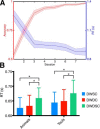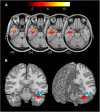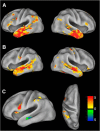Multivariate Pattern Analysis Reveals Category-Related Organization of Semantic Representations in Anterior Temporal Cortex
- PMID: 27683905
- PMCID: PMC6705575
- DOI: 10.1523/JNEUROSCI.1599-16.2016
Multivariate Pattern Analysis Reveals Category-Related Organization of Semantic Representations in Anterior Temporal Cortex
Abstract
The neural substrates of semantic representation have been the subject of much controversy. The study of semantic representations is complicated by difficulty in disentangling perceptual and semantic influences on neural activity, as well as in identifying stimulus-driven, "bottom-up" semantic selectivity unconfounded by top-down task-related modulations. To address these challenges, we trained human subjects to associate pseudowords (TPWs) with various animal and tool categories. To decode semantic representations of these TPWs, we used multivariate pattern classification of fMRI data acquired while subjects performed a semantic oddball detection task. Crucially, the classifier was trained and tested on disjoint sets of TPWs, so that the classifier had to use the semantic information from the training set to correctly classify the test set. Animal and tool TPWs were successfully decoded based on fMRI activity in spatially distinct subregions of the left medial anterior temporal lobe (LATL). In addition, tools (but not animals) were successfully decoded from activity in the left inferior parietal lobule. The tool-selective LATL subregion showed greater functional connectivity with left inferior parietal lobule and ventral premotor cortex, indicating that each LATL subregion exhibits distinct patterns of connectivity. Our findings demonstrate category-selective organization of semantic representations in LATL into spatially distinct subregions, continuing the lateral-medial segregation of activation in posterior temporal cortex previously observed in response to images of animals and tools, respectively. Together, our results provide evidence for segregation of processing hierarchies for different classes of objects and the existence of multiple, category-specific semantic networks in the brain.
Significance statement: The location and specificity of semantic representations in the brain are still widely debated. We trained human participants to associate specific pseudowords with various animal and tool categories, and used multivariate pattern classification of fMRI data to decode the semantic representations of the trained pseudowords. We found that: (1) animal and tool information was organized in category-selective subregions of medial left anterior temporal lobe (LATL); (2) tools, but not animals, were encoded in left inferior parietal lobe; and (3) LATL subregions exhibited distinct patterns of functional connectivity with category-related regions across cortex. Our findings suggest that semantic knowledge in LATL is organized in category-related subregions, providing evidence for the existence of multiple, category-specific semantic representations in the brain.
Keywords: anterior temporal lobe; language; learning; multivariate pattern analysis; reading; semantic memory.
Copyright © 2016 the authors 0270-6474/16/3610089-08$15.00/0.
Figures





References
Publication types
MeSH terms
Grants and funding
LinkOut - more resources
Full Text Sources
Other Literature Sources
